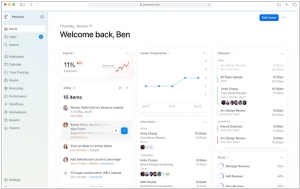Nutanix vs OpenStack
March 08, 2025 | Author: Michael Stromann
9★
The industry’s most popular hyperconverged infrastructure (HCI) solution. Effortlessly leverage cloud-like agility and ease of use, coupled with on-premises security and control, as you leave behind the complexity and cost of legacy solutions.
19★
OpenStack is a global collaboration of developers and cloud computing technologists producing the ubiquitous open source cloud computing platform for public and private clouds. The project aims to deliver solutions for all types of clouds by being simple to implement, massively scalable, and feature rich. The technology consists of a series of interrelated projects delivering various components for a cloud infrastructure solution.
Nutanix and OpenStack are both terribly clever ways of making computers behave like they belong in the 21st century. They take all that messy business of compute, storage and networking and roll it into something vaguely resembling order, allowing businesses to build private and hybrid clouds without (too much) screaming. Both can scale heroically, integrate with various tools and promise to make cloud management less of a Kafkaesque nightmare. In essence, they exist to convince large, bewildered IT teams that infrastructure can be both powerful and—dare we say—usable.
Nutanix, being a commercially developed American product (because of course it is), wants to make things simple. It’s hyper-converged, meaning it bundles everything up nicely with a bow, so enterprises can deploy their own cloud without needing a PhD in "What The Hell Did I Just Install?" First appearing in 2011, it’s aimed at businesses that would rather focus on, well, business, instead of battling infrastructure dragons. You plug it in, push some buttons, and—barring some interdimensional IT mishap—you have yourself a cloud.
OpenStack, on the other hand, is open-source and therefore has a rather different philosophy: "You want a cloud? Here are the blueprints, a screwdriver and an enthusiastic mailing list." Originally launched by NASA and Rackspace in 2010 (because space and the internet clearly needed more complexity), OpenStack is perfect for those who like tinkering with infrastructure down to its atomic level. Telecoms, research institutions and companies with an unnatural love for customization swear by it, though deploying it can often feel like assembling a spaceship with nothing but a vague user manual and a lot of hope.
See also: Top 10 Virtualization platforms
Nutanix, being a commercially developed American product (because of course it is), wants to make things simple. It’s hyper-converged, meaning it bundles everything up nicely with a bow, so enterprises can deploy their own cloud without needing a PhD in "What The Hell Did I Just Install?" First appearing in 2011, it’s aimed at businesses that would rather focus on, well, business, instead of battling infrastructure dragons. You plug it in, push some buttons, and—barring some interdimensional IT mishap—you have yourself a cloud.
OpenStack, on the other hand, is open-source and therefore has a rather different philosophy: "You want a cloud? Here are the blueprints, a screwdriver and an enthusiastic mailing list." Originally launched by NASA and Rackspace in 2010 (because space and the internet clearly needed more complexity), OpenStack is perfect for those who like tinkering with infrastructure down to its atomic level. Telecoms, research institutions and companies with an unnatural love for customization swear by it, though deploying it can often feel like assembling a spaceship with nothing but a vague user manual and a lot of hope.
See also: Top 10 Virtualization platforms





